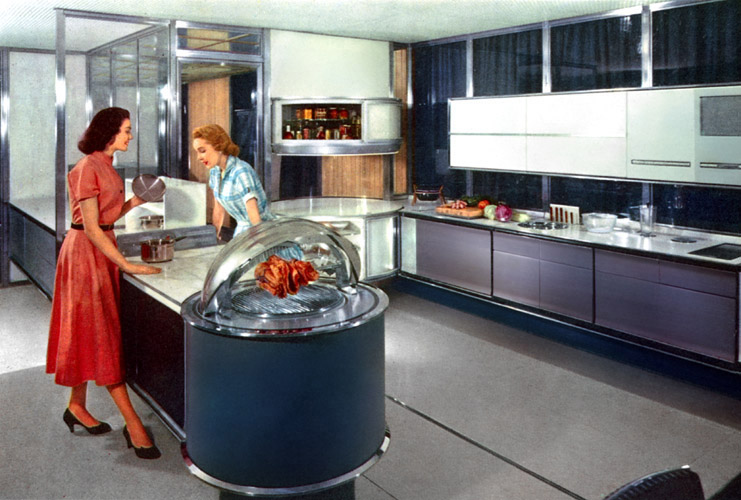 ...Or at least your barcodes, which more marketing experts are hoping will be an extension of your thoughts and needs. In this case, the point-of-sale moves even further into your home and automatically into your pantry.
...Or at least your barcodes, which more marketing experts are hoping will be an extension of your thoughts and needs. In this case, the point-of-sale moves even further into your home and automatically into your pantry.
Warren Belasco’s new book, Meals to Come looks at the future of food and cooking, noting how scholars have consider the meal-in-a pill, the thinking kitchen, and automated grocery shopping since before the 1939 World’s Fair. My favorite image is from around the 1950s, showing a gleaming metal and plastic kitchen with no actual food, mess, or cooking smells, but a space age mom pulling fully prepared trays from the automatic fridge-oven combo.
In some ways, we’re certainly closer to that image today than ever before. Prepared foods for both in-store and take out consumption have become a growth industry for supermarkets. Delivery grocery services like PeaPod and NetGrocer will even bring your fresh and prepared foods right to your door. And now, appliance manufacturers are edging up to the futurama kitchen with a refrigerator that allows you to swipe a product’s barcode directly into the appliance, creating a grocery list that can be transmitted to the store immediately. Incorporating microprocessors, touch screens, and internet communications into your kitchen means no more running out for milk at 10 pm. Imagine downloading a recipe, comparing the ingredient list against what’s in your refrigerator, and sending out a shopping order for what’s not. It is the DreamWorld of the 50s come to fruition.
Wait, wait, wait. I hate to be the Luddite in the Temple of Future Goodness, but is this really necessary? Or better? (I’m not even going to mention the international food crisis as one reason why this technology might appear a bit excessive. Okay, well, I am. But Belasco ties these things together, too: if we want the kitchen of the future, we have to create a future where access to good food remains constant for the global population and doesn’t deplete resources unevenly).
Even if we don’t end global hunger today, how far we can go with smart appliances and customized, immediate food sales? At least let’s consider whether it’s worth the effort:
1. Are new techno-smart kitchen appliances a growth market? GE, one of the oldest and the second largest appliance manufacturers in the US, just announced that it likely going to sell off its century-old but slow growth appliance line. This doesn’t mean people won’t buy stoves, refrigerators, and washing machines in the near future – but creating a whole new product line means you’d better be sure there’s enough income and desire out there for such big purchases. Right now replacing old televisions and laptops seem to be a more pressing consumer concern. Consider also that the market for new appliances is going to be energy-efficient, green and with greater recycle-ability. When manufacturers add in new circuitry, screens, and other technology, they might want to make sure they’re LEED compliant first.
2. Isn’t this a bit redundant? The goal is to move people away from doing online shopping on their computers and having it dispersed throughout the household. But what if my cell phone can do all that work for me? It’s small, I can take it everywhere I want in the house (scan the barcode on my laundry detergent, my shampoo, and my milk, all in one handy device!) Why incorporate it into a refrigerator? As one shopper told me, “the more gadgetry they stick on the microwave, the more expensive it is when it breaks. You’re usually stuck just going out and getting a new one.”
3. Fast, free delivery is often neither. Aside from the fun technology, one factor hidden in these point-of-sale-to-your-doorstep services is the difficulties and costs of delivering that milk. First, there’s the cost of gasoline. Just ask my local milkman, whose prices just went up (and yes, speaking of the 1950s, when we're in Massachusetts, we have a milk delivery service complete with the cute insulated milk box on the doorstep -- and if you want it, glass milk bottles. It’s local, organic, and we never run out). Whole Foods, which has just started its own home-delivery option, is only selling dried and canned goods at this point. While Amazon has proven the cost saving measures of virtual stores, it’s much more difficult to get people to standardize their weekly grocery purchases than their occasional book buying (think about how much you believe in the accuracy of Amazon’s “personal” recommendations based on your past purchases.)
4. Who needs this the most? Consider the people who would most likely benefit from this technology: people who are less mobile, like senior citizens and new parents, people in urban food deserts, where there are no nearby grocery stores, and others in rural or geographically less accessible sites. But these are not the consumer groups most likely to pay the premium price for these techno-savvy appliances.
So, until they get all the kinks worked out, I think we’ll put off that kitchen remodeling job a bit longer.
Tags: shopping, self-service
Tuesday, May 20, 2008
The refrigerator can read your mind
Posted by
Annie
at
1:15 PM
![]()
Labels: self-service, shopping


 Subscribe to this blog
Subscribe to this blog
No comments:
Post a Comment